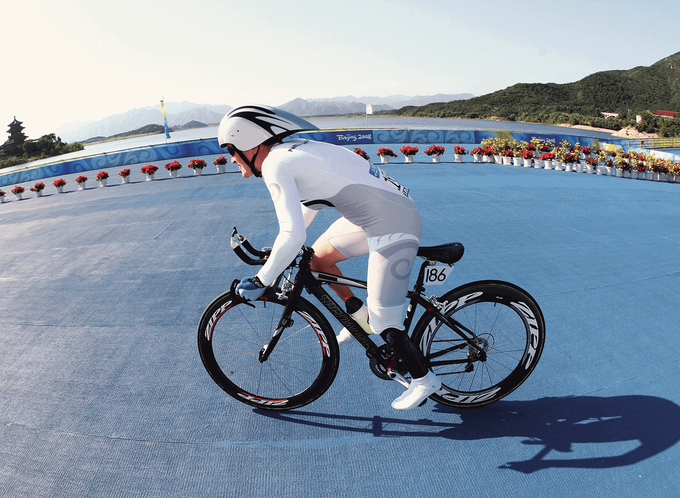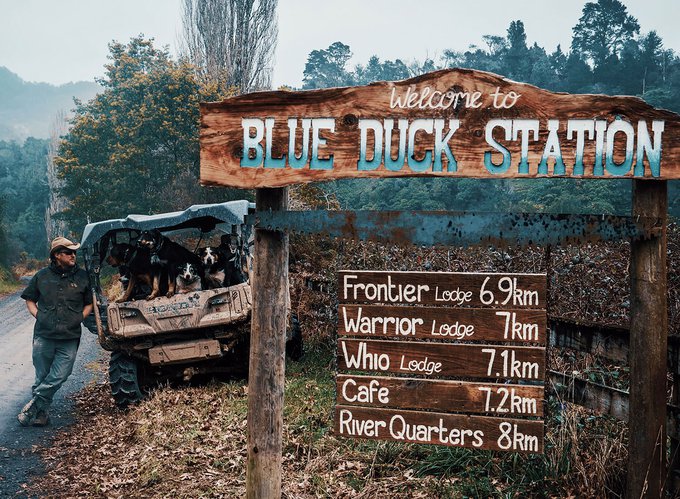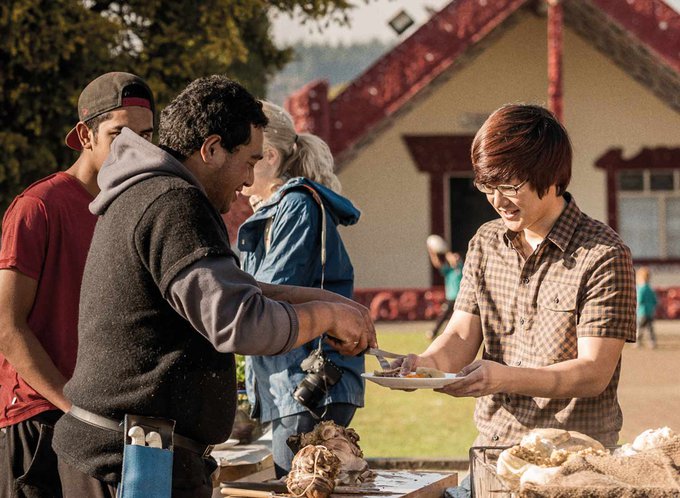All my life, I’d dreamed of Venice but been afraid to visit. In my dreams, Venice was a Canaletto painting of the Grand Canal from the 1720s that I first saw as a teenager.
It was a vision of impossible exoticism – ornate stone warehouses and delicate Byzantine palazzo rising from a wide avenue of shining water, buzzing with working boats transporting the luxury trade goods that made Venice the wealthiest and most influential city in the world for over 500 years.
I was afraid to visit because I’d read the news. Modern Venice had become an overcrowded fetishised parody of itself. The once-grand palazzo were sinking under their own weight, their exteriors crumbling, and the city was now a smelly, overpriced cliché.
But I had to visit, just once. So my wife and I booked for October to see the end of the Venice Biennale when the nights were cooler and after the rush of peak season and hordes of tourists.
The world’s most famous contemporary art show was brilliant, but I didn’t expect our hotel to leave us with even deeper lasting impressions.
No ordinary hotel
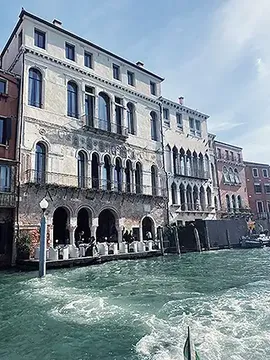
We had been told about the Venice Venice Hotel by a friend. It’s new, barely a year old and unlisted on the aggregated booking sites that are staple for travel planning these days. You have to book directly via its website.
On the website the hotel founders claim that this is no ordinary hotel project – it’s the first expression of a cultural and aesthetic movement they call “Postvenezianità’’, their attempt to show the world that Venice is more than just a pretty place stuck in a time warp. They want us to see Venice remains a city of powerful ideas and influence that looks forward and inspires the world to imagine a better future.
The driving force behind Postvenezianità is Alessandro Gallo and Francesca Rinaldo, the Venetian couple who created the ultra-premium Golden Goose sneaker brand, which sells custom-distressed sneakers sometimes held together by duct tape for up to US$700. The brand was launched in 2000 and is now owned by an investment company with a valuation in the billions. Their pre-scuffed sneakers are favoured by Hollywood A-listers and have been occasionally condemned by activists for fetishising poverty.
Like any good Italian movement, Postvenezianità has a manifesto. And in true Italian intellectual form, theirs is heroic in its ambition and magnificently verbose, dancing on the head of a needle that wavers between pretentious and intoxicating. The central idea is that the Venice of bygone centuries should not be slavishly reproduced but reimagined as a launching pad for new ideas. At the heart of the manifesto is the rhetorical question “but isn’t Venice above all avant-garde?”
I confess I was sceptical as I booked from my kitchen table. Surely this was just another expensive designer hotel? It turns out I couldn’t have been more wrong.
A grand entrance
You arrive at the Venice Venice Hotel’s Grand Canal entrance by boat. The entrance doors sit beside the restaurant terrace, the only place in Venice you can eat without a guard rail beside the Grand Canal, watching the constant traffic of barges, elegant wooden water taxis and gondolas.
The hotel entrance surely breaks every rule of classic hotel design. Smoked glass doors open slowly and you enter expecting a chic, brightly lit hotel lobby. Instead, you find yourself in a bizarre netherworld.
The light is dimmed, you pause to let your eyes adjust and the doors close behind you. Underfoot are slabs of polished stone at different levels, separated by water. It’s eerily quiet, and the air temperature suddenly cools so it’s sharp on your bare arms.
The space is quiet, and you immediately notice a familiar white marble sculpture. You know it, but it doesn’t belong here. It’s a replica of Michelangelo’s masterpiece La Pietá from St Peter’s in Rome. The original is the ultimate work by the renaissance master, a homage to a mother’s love, Mary heartbroken as she cradles a dead Jesus in her arms.
But this Pietá is different. Jesus is gone. Her arms are empty and she looks down at a rough-hewn space from whence the Saviour of the World has been wrenched. As your eyes adjust, you scan across the space. You realise Jesus is there, sculpted in white marble like the original, but deliberately placed apart. Jesus is lying alone in a pool of water on the other side of the foyer.
It’s a work by contemporary Italian sculptor Fabio Viale. He sculpts using the same techniques as Michelangelo, with chisels and his bare hands. He first showed his Pietá without Christ in 2018 at the Venice Biennale, with a naked African man, a Catholic religious refugee from Nigeria named Lucky Ehi lying naked in the arms of Mary. Alessandro Gallo was so moved by the work he bought it and designed the entrance of his Venice Venice Hotel to share it with his guests.
It must be the most unnerving entrance experience of any hotel in the world. Conrad Hilton would be confounded. This isn’t a space trying to impress us with glamour and opulence. It’s a direct confrontation to all that, a challenge to us, the privileged, to change the way we think. Postvenezianità expressed
as a hotel lobby.

The Venice Venice Hotel’s water entrance is on the Grand Canal

Mary looks at the empty space from whence the saviour of the world has been wrenched.
Restoring Venetian history
The hotel opened in 2022 following a five-year restoration and redesign of a 13th century palazzo that embodies Venice’s rich history like few others.
The building, Ca’ da Mosto, began life as Venice’s first stone warehouse 900 years ago, a single-storey trading warehouse for the renowned da Mosto merchant family. In the 16th century, at the apogee of Venetian wealth and power, two grand additional floors were added. In the 19th century, another floor was added and the building became the most celebrated hotel in Europe – the Leon Bianco – playing host to czars, emperors, artists, poets and writers.
Then, some time early in the 20th century, the building fell into chronic disrepair. Its foundations slumped, the basement flooded and it was divided into multiple crumbling apartments before it was finally abandoned.
The restoration project was truly epic, taking over five years. The original structure was strengthened, preserving as much of the original as possible and leaving the layers of age for all to see.
Most of the walls are original and the new reinforced concrete floors on each level follow their rolling contours. In some places, 900-year-old bricks are exposed. Where the original plaster of a 16th century ceiling is held in place by fixing bolts, they’re left on display so the line between new and old is clear.
Where new elements have been added, it’s clearly the craft of contemporary artisans – from the rough carved marble dado rails laid on ancient bricks to hand-blown Murano glass light shades and the hotel’s custom-made ceramics. The building feels modern but old at the same time. Throughout the hotel are works of leading contemporary European artists, all of whom offer a twist to classic techniques like Fabio Viale. Each room is dedicated to an individual artist and contains several original works. You can also buy designer-distressed Golden Goose sneakers in the shop. Clearly it’s easier to sell your sneaker company than it is to stop selling your sneakers.
Or perhaps the sneakers offer a window into what the owners are trying to achieve here. Brand-new Golden Goose sneakers get more street cred through the designer distress process. Similarly, the contemporary art and design elements of the Venice Venice Hotel are empowered with 900 years of history because the old building shows through, like scuffs on a sneaker.
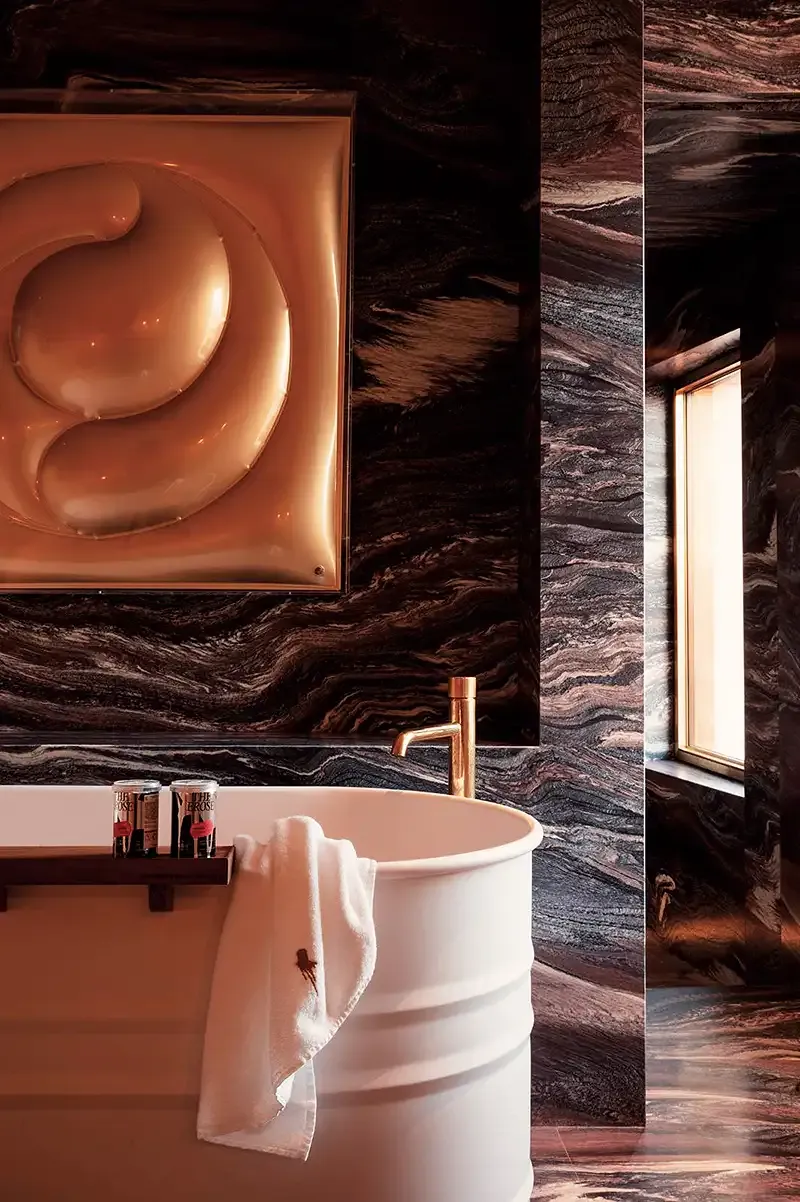
Above / Every room of the hotel is dedicated to an individual artist and contains several original works.
Every room of the hotel is dedicated to an individual artist and contains several original works.
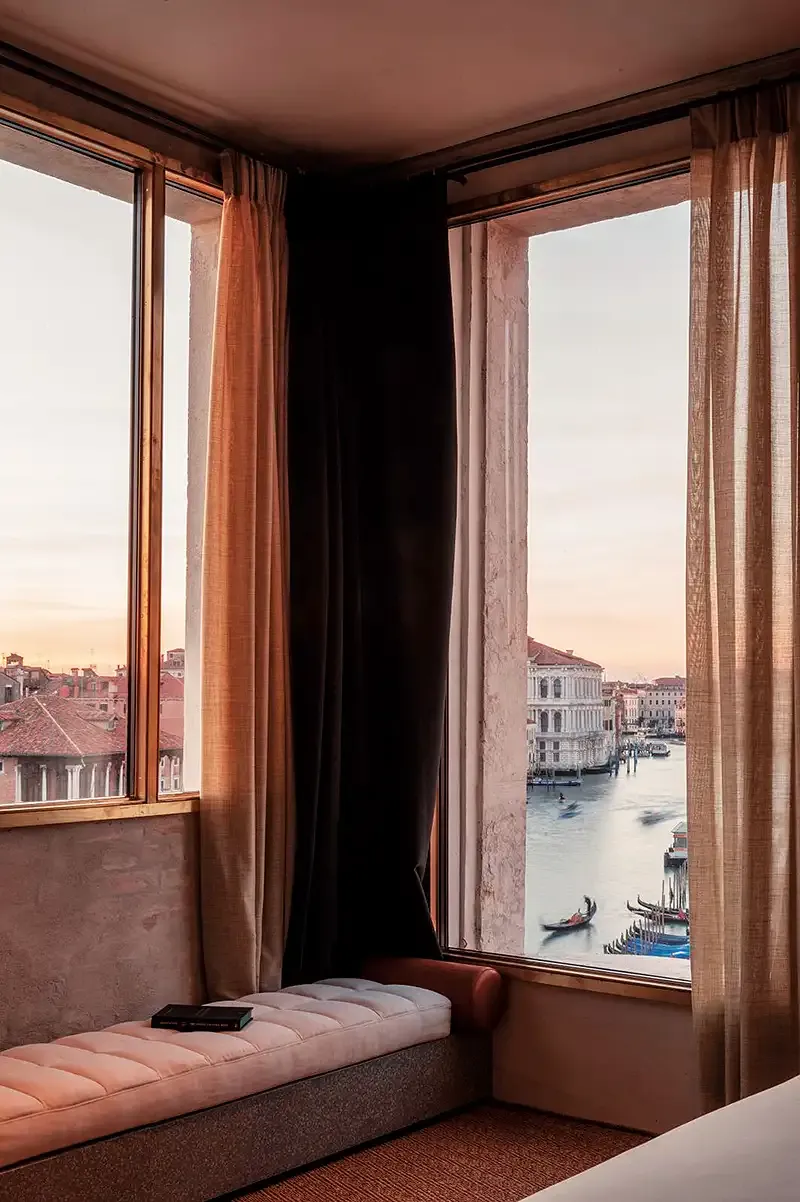
Every room of the hotel is dedicated to an individual artist and contains several original works.
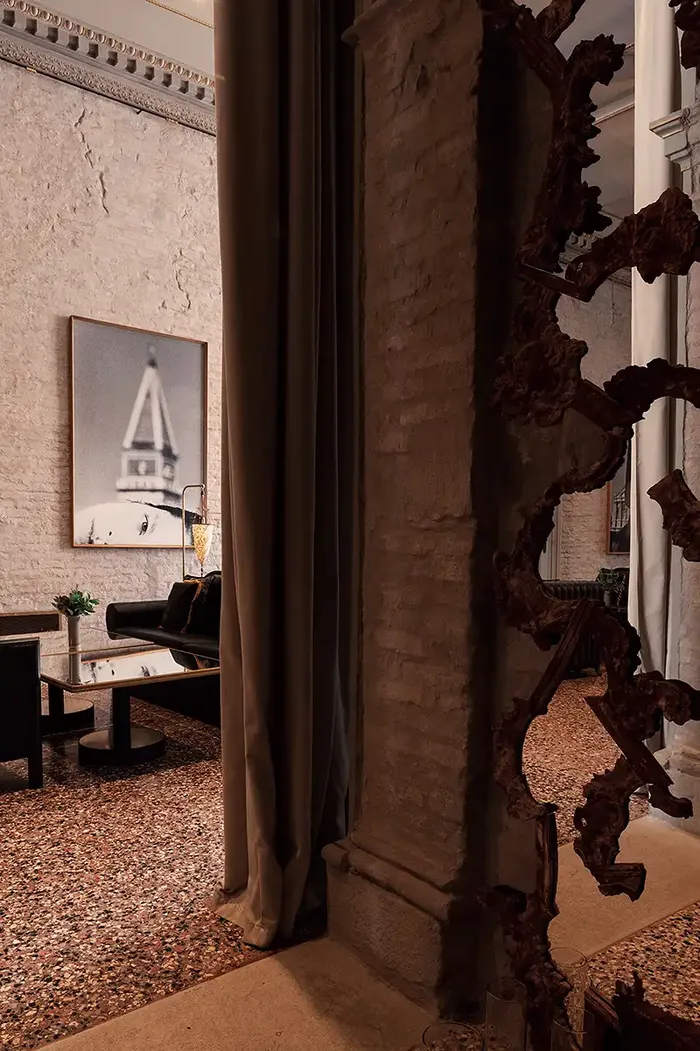
Top / Every room of the hotel is dedicated to an individual artist and contains several original works.
Bottom / The hotel undertook an epic restoration project.
The hotel undertook an epic restoration project.
Accessible luxury
There’s a lot that makes Venice Venice Hotel remarkable, but most surprising is the accessibility of it all. Most of the world’s exotic hotels are designed to be off limits to anyone except their rich paying guests. But Venice Venice Hotel, true to its manifesto, opens its arms to anyone to spend a day there.
Throughout the hotel’s public spaces was a constant smattering of 20-somethings on laptops. Who knows why they were there, but they did have the look of young people being creative. They certainly weren’t ordering lavish platters from the restaurant. I’m told their policy is never to kick anyone out for not buying anything. I guess there’s a tacit promise that while you’re at the Venice Venice you’re imagining a better world.
Canaletto window scene
When we made it to our room on the first floor, there was one final unexpected moment. The rooms are, of course, beautiful, but it wasn’t the interior that caught my breath when we opened the window and looked out onto the Grand Canal.
I knew every inch of the view. Canaletto had been there before in 1730 painting a picture I first saw when I was 19. Looking out at a scene that really hasn’t changed for 400 years, I wondered, if Canaletto was around today, what kind of art he’d make and what brand of sneakers he’d wear.
Know someone who might enjoy this?
Read this next
-
March 2021
Land, sea and myth: Revisiting Hawke's Bay
-
July 2021
On track for Tokyo
-
November 2021
A world of good
-
November 2022
Proceeding creatively
Good living
See all-
March 2021
In review
-
March 2021
Manaakitanga – more than just hospitality
-
March 2021
Land, sea and myth: Revisiting Hawke's Bay
-
July 2021
Breaking bread at Everybody Eats

